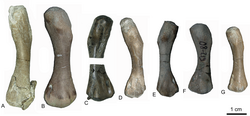| Anarosaurus Temporal range:
Anisian,
| |
|---|---|

| |
| Anarosaurus heterodontus humeri | |
|
Scientific classification
| |
| Domain: | Eukaryota |
| Kingdom: | Animalia |
| Phylum: | Chordata |
| Class: | Reptilia |
| Superorder: | † Sauropterygia |
| Family: | † Pachypleurosauridae |
| Genus: | †
Anarosaurus Dames, 1890 |
| Species | |
Anarosaurus is an extinct genus of pachypleurosaurs that lived in the Middle Triassic period ( Anisian) and has been found in the Jena Formation and the Karlstadt Formation of Germany and the Winterswijk Quarry ( Lower Muschelkalk) of The Netherlands. [1] Two species are known: A. pumilio (the type species) [2] and A. heterodontus. [3] The holotype of A. pumilio was originally housed at the Institut und Museum fur Geologie und Palaontologie, Georg-August-Universitat, Gottingen, but can no longer be located today because it was lost or destroyed during World War II. [4] Anarosaurus was a small reptile with an estimated body length of 50–60 cm (1.6–2.0 ft). [5]
See also
References
- ^ Klein, N. (2009). "Skull morphology of Anarosaurus heterodontus (Reptilia: Sauropterygia: Pachypleurosauria) from the Lower Muschelkalk of the Germanic Basin (Winterswijk, the Netherlands)". Journal of Vertebrate Paleontology. 29 (3): 665–676. Bibcode: 2009JVPal..29..665K. doi: 10.1671/039.029.0327. S2CID 86204928.
- ^ Dames, W. (1890) Anarosaurus pumilio nov. gen. nov. sp. Zeitschrift der Deutschen Geologischen Gesellschaft 42:74-85.
- ^ O. Rieppel and K. Lin. (1995) Pachypleurosaurs (Reptilia: Sauropterygia) from the Lower Muschelkalk, and a review of the Pachypleurosauroidea. Fieldiana: Geology, new series (32)1-44
- ^ Kuhn O. (1971), Die Saurier der deutschen Trias [Reptiles of the German Triassic], 1-105
- ^ Houssaye, A. (2013). "Bone histology of aquatic reptiles: what does it tell us about secondary adaptation to an aquatic life?". Biological Journal of the Linnean Society. 108 (1): 3–21. doi: 10.1111/j.1095-8312.2012.02002.x. S2CID 82741198.
| Anarosaurus Temporal range:
Anisian,
| |
|---|---|

| |
| Anarosaurus heterodontus humeri | |
|
Scientific classification
| |
| Domain: | Eukaryota |
| Kingdom: | Animalia |
| Phylum: | Chordata |
| Class: | Reptilia |
| Superorder: | † Sauropterygia |
| Family: | † Pachypleurosauridae |
| Genus: | †
Anarosaurus Dames, 1890 |
| Species | |
Anarosaurus is an extinct genus of pachypleurosaurs that lived in the Middle Triassic period ( Anisian) and has been found in the Jena Formation and the Karlstadt Formation of Germany and the Winterswijk Quarry ( Lower Muschelkalk) of The Netherlands. [1] Two species are known: A. pumilio (the type species) [2] and A. heterodontus. [3] The holotype of A. pumilio was originally housed at the Institut und Museum fur Geologie und Palaontologie, Georg-August-Universitat, Gottingen, but can no longer be located today because it was lost or destroyed during World War II. [4] Anarosaurus was a small reptile with an estimated body length of 50–60 cm (1.6–2.0 ft). [5]
See also
References
- ^ Klein, N. (2009). "Skull morphology of Anarosaurus heterodontus (Reptilia: Sauropterygia: Pachypleurosauria) from the Lower Muschelkalk of the Germanic Basin (Winterswijk, the Netherlands)". Journal of Vertebrate Paleontology. 29 (3): 665–676. Bibcode: 2009JVPal..29..665K. doi: 10.1671/039.029.0327. S2CID 86204928.
- ^ Dames, W. (1890) Anarosaurus pumilio nov. gen. nov. sp. Zeitschrift der Deutschen Geologischen Gesellschaft 42:74-85.
- ^ O. Rieppel and K. Lin. (1995) Pachypleurosaurs (Reptilia: Sauropterygia) from the Lower Muschelkalk, and a review of the Pachypleurosauroidea. Fieldiana: Geology, new series (32)1-44
- ^ Kuhn O. (1971), Die Saurier der deutschen Trias [Reptiles of the German Triassic], 1-105
- ^ Houssaye, A. (2013). "Bone histology of aquatic reptiles: what does it tell us about secondary adaptation to an aquatic life?". Biological Journal of the Linnean Society. 108 (1): 3–21. doi: 10.1111/j.1095-8312.2012.02002.x. S2CID 82741198.






